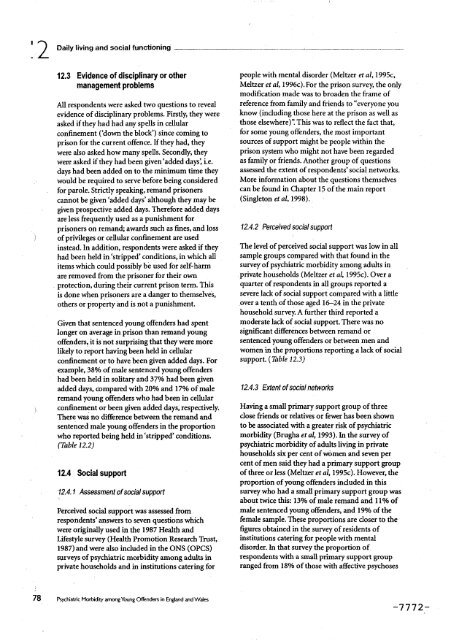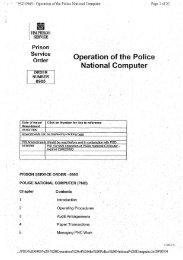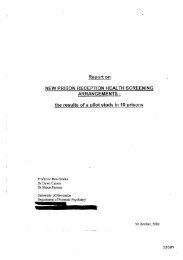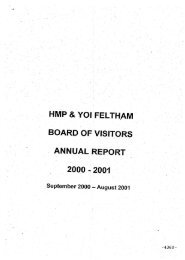Neurotic disorders
Neurotic disorders
Neurotic disorders
Create successful ePaper yourself
Turn your PDF publications into a flip-book with our unique Google optimized e-Paper software.
.! 2 Daily living and social functioning<br />
12.3 Evidenceof disciplinaryor other peoplewith mentaldisorder(Mehzer et al, 1995c,<br />
management problems<br />
Meltzer et ai, 1996c). For the prison survey, the only<br />
modification made was to broaden the frame of<br />
All respondents were asked two questions to reveal reference from family and friends to "everyone you<br />
evidence of disciplinary problems. Firstly, they were know (indudingthose here at the prison as well as<br />
asked if they had had any spells in cellular<br />
those elsewhere)". This was to reflect the fact that,<br />
confinement ('down the block') since coming to for some young offenders, the most important<br />
prison for the current offence. If they had, they sources of support might be people within the<br />
were also asked how many spells. Secondly, they prison system who might not have been regarded<br />
were asked if they had been given'added days', i.e. as family or friends. Another group of questions<br />
days had been added on to the minimum time they assessed the extent of respondents' social networks.<br />
would be required to serve before being considered More information about the questions themselves<br />
for parole. Strictly speaking, remand prisoners can be found in Chapter 15 of the main report<br />
cannot be given 'added days' although they may be (Singleton et al, 1998).<br />
given prospective added days. Therefore added days<br />
are less frequently used as a punishment for<br />
prisoners on remand; awards such as fines, and loss 12.4.2 Perceivedsocialsupport<br />
of privileges or ceUular confmement are used<br />
instead. In addition, respondents were asked if they The level of perceived social support was low in all<br />
had been held in 'slxipped' conditions, in which all sample groups compared with that found in the<br />
items which could possibly be used for self-harm surveyor psychiatric morbidity among adults in<br />
are removed from the prisoner for their own private households (Meltzer et al, 1995c). Over a<br />
protection, during their current prison term. This quarter of respondents in all groups reported a<br />
is done when prisoners are a danger to themselves, severe lack of social support compared with a little<br />
others or property and is not a punishment, over a tenth of those aged 16-24 in the private<br />
household survey. A further third reported a<br />
Given that sentenced young offenders had spent moderate lack of social support. There was no<br />
longer on average in prison than remand young significant differences between remand or<br />
offenders, it is not surprising that they were more sentenced young offenders or between men and<br />
likely to report having been held in cellular women in the proportions reporting a lack of social<br />
confinement or to have been given added days. For support. (Table 12.3)<br />
example, 38% of male sentenced young offenders<br />
had been held in solitary and 37% had been given<br />
added days, compared with 20% and 17% of male 12.4.3 Extentof socialnetworks<br />
remand young offenders who had been in cellular<br />
confinement or been given added days, respectively. Having a small primary support group of three<br />
There was no difference between the remand and dose friends or relatives or fewer has been shown<br />
sentenced male young offenders in the proportion to be associated with a greater risk of psychiatric<br />
who reported being held in'stripped' conditions, morbidity (Brugha et al, 1993). In the survey of<br />
(Table 12.2) psychiatric morbidity of adults living in private<br />
households six per cent of women and seven per<br />
cent of men said they had a primary support group<br />
12.4 Socialsupport of three or less (Meltzer et al, 1995c). However, the<br />
proportion of young offenders included in this<br />
12.4.1 Assessment of social support survey who had a small primary support group was<br />
'<br />
about twice this: 13% of male remand and 11% of<br />
Perceived social support was assessed from male sentenced young offenders, and 19% of the<br />
respondents' answers to seven questions which female sample. These proportions are closer to the<br />
were originally used in the 1987 Health and figures obtained in the survey of residents of<br />
Lifestyle survey (Health Promotion Research Trust, institutions catering for people with mental<br />
1987) and were also included in the ONS (OPCS) disorder. In that survey the proportion of<br />
surveys of psychiatric morbidity among adults in respondents with a small primary support group<br />
private households and in institutions catering for ranged from 18% of those with affective psychoses<br />
78 PsychiatricMorbidity amongYoungOffenders in EnglandandWales<br />
-7772-

















